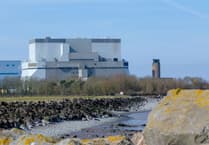THE first phase of Somerset’s new £4bn gigafactory could begin to take shape before Christmas, if plans are successfully approved.
Agratas announced in late-February that it would be investing heavily in the Gravity enterprise zone, between Puriton and Woolavington, creating up to 4,000 well-paid jobs and delivering one of the largest single employment sites in the whole of Somerset.
The facility, which is expected to be up and running by 2026, will provide electric vehicle batteries for Jaguar Land Rover, and could eventually provide up to 40 per cent of all electric vehicle batteries for the UK domestic market.
Construction firm McAlpine was awarded the contract in late-July for the pre-construction work on the former Royal Ordnance Factory site, with its staff hard at work at the site’s south-western corner.
Agratas has now formally submitted plans for the prosaically named ‘Building One’, which will form the first phase of the new complex – with a decision expected from Somerset Council before Christmas.
The entire Gravity enterprise zone has been subject to a local development order (LDO) since December 2021, in a bid to speed up the delivery of any investment within the site. Under the phase one proposals, building one will be constructed at the western edge of the site, with large amounts of car parking being provided to the north, south and west.
The majority of this building will be devoted to battery cell manufacturing, but it will also include staff welfare facilities such as a canteen.
A separate building will be constructed to the east, housing the electrolyte used to construct the lithium batteries and a new substation which will be needed to power the gigafactory (on top of the ongoing upgrades to Bridgwater’s own power grid).
A new orbital road will be created around the perimeter of the Gravity site, with incoming materials being delivered at a depot on the northern side and all outbound goods being stored in a warehouse on the southern side.
This orbital road will include numerous bus stops and walking and cycling facilities, linking up with the existing cycle route along Enterprise Way and the proposed links to Woolavington which receives planning approval in May 2023.
At the northern edge of the site, a large green buffer will be created with new trees and grassland, providing a suitable transition between the site and the Huntspill River nature reserve.
This buffer includes a possible attenuation basin, which will be constructed near the defunct channel formerly used to provide water from the Huntspill River.
A spokesman for Agratas said: “The design maximises the available land use by locating the higher part of building one along the western boundary line.
“The master-plan has been developed in a fully coordinated way, with the buildings, transport and logistics and drainage strategies brought together by our coordinated design team to efficiently use space and maximise the potential future land area available for development to the east of building one and the ancillary buildings for future phases of development.”
The gigafactory site is currently accessed primarily through Enterprise Way, which was completed in 2019 at a cost of £10.3m and links the site to the A39 Bath Road near junction 23 of the M5.
The road runs around the eastern edge of Puriton, skirting alongside the Polden Orchards development of 120 houses currently being constructed by Redrow Homes.
While there is a wide pavement for much of its length, the section nearest the A39 roundabout only has a narrow, stony path alongside it, making it challenging for less able pedestrians to navigate.
Somerset Council stated in early-June that this road alone would not provide sufficient capacity to access the site, given the scale of production that would be undertaken once the new gigafactory is up and running.
A spokesman said: “The specification of this access road was based on the outline planning consent granted in 2017 and does not reflect the requirements or expectations for larger scale advanced manufacturing inward investment.”
The council committed in March to spending up to £150m on delivering infrastructure to unlock the gigafactory development., funded through central government grants and retention of business rates from the site.
Of this, up to £74m will be spent on transport improvements – which may include the creation of a ‘junction 22A’ to provide direct access from the M5, and restoring the former rail link with the Bristol to Exeter mainline.
Any new motorway junction would be funded by the Department for Transport (DfT), with the council providing the funding from the new junction to the Gravity site.
The council has not yet specified a precise location for junction 22A, though it is likely to be south of the Huntspill River, providing the shortest route from the motorway to the Gravity site and minimising damage to both the key flood defence and the local nature reserve.
In the short term, traffic flow from junction 23 of the M5 will be improved as part of the council’s long-awaited upgrade of the Dunball roundabout (funded by the government’s levelling up fund), which is expected to get under way later in the autumn.
This upgrade will include improvements to pedestrian and cycling links, providing an improved connection to Bridgwater town centre via the River Parrett and to the existing on-road provision through Puriton.
The route from Bridgwater town centre to the Gravity site – via a footbridge over the motorway north of junction 23 – forms part of the aspirational ‘purple route’ identified within the Bridgwater local cycling and walking infrastructure plan (LCWIP), which was published in 2022.
The council is expected to make a decision on the latest Agratas proposals before Christmas.




